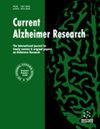评估和表征用于定位啮齿动物斑块和人类脑组织中斑块与纠结的改良 K114 方法
IF 1.9
4区 医学
Q3 CLINICAL NEUROLOGY
引用次数: 0
摘要
背景:大量研究表明,几种化学染料能亲和性地结合 Aβ,从而在光镜或荧光显微镜下观察斑块,其中一些染料还能亲和性地结合神经纤维缠结(NFT)。然而,只有少数几种药物具有同时结合老年斑(SP)和神经纤维缠结(NFT)的倾向。研究目的在目前的研究中,我们旨在改进 K114 染料和染色程序,以大幅提高人脑和啮齿类动物大脑中淀粉样斑块和人脑中神经纤维缠结的染色效果:我们使用苏丹黑作为改良剂,对 K114 溶液和染色程序进行了改良。此外,为了评估改良后 K114 的靶标,我们对 K114 进行了双标记,并增加了针对三种不同表位的 Aβ。我们使用了 5 种不同的抗体来检测磷酸化 tau,以了解修饰后的 K114 结合的特定靶标:我们使用苏丹黑作为改性剂对 K114 溶液和染色过程进行了改良。此外,为了评估修饰 K114 的靶标,我们对 K114 和针对三种不同表位的 Aβ 进行了双重标记。我们使用了 5 种不同的抗体来检测磷酸化的 Tau,以了解潜在的结合靶点。结果:使用针对AT8、pTau和TNT1的高磷酸化抗体进行双重标记发现,80%以上的高磷酸化tau与修饰K114阳性的缠结聚集在一起,而70%以上的高磷酸化tau与修饰K114聚集在一起。另一方面,超过 80% 的用 Aβ MOAB-2 染色的斑块与修饰的 K114 共聚焦:我们发现 80% 以上的针对 AT8、PTau 和 TNT1 的高磷酸化 Tau 与 K114 标记的缠结共聚焦,而 70% 以上的高磷酸化 Tau 与修饰的 K114 共聚焦。另一方面,超过 80% 的淀粉样 beta MOAB-2 染色斑块与修饰的 K114 共聚焦。结论我们改进的方法可在 5 分钟内标记大鼠大脑中的淀粉样蛋白斑块,在 20 分钟内标记人脑中的淀粉样蛋白斑块。我们的研究结果表明,与其他传统荧光标记物相比,改良的 K114 可用作检测淀粉样蛋白斑块和纠结的重要工具,具有高对比度和高分辨率。本文章由计算机程序翻译,如有差异,请以英文原文为准。
Evaluation and Characterization of Modified K114 Method to Localize Plaques in Rodent and Plaques and Tangles in Human Brain Tissue
Background: A plethora of studies has shown the utility of several chemical dyes due to their affinity to bind Aβ to enable visualization of plaques under light or fluorescence microscope, and some of them showed affinity to bind neurofibrillary tangles (NFT) as well. However, only a few of them have the propensity to bind both senile plaques (SP) and NFT simultaneously. Objective: In our current study, we aimed to modify the K114 dye and the staining procedure to substantially improve the staining of amyloid plaques in both human and rodent brains and neurofibrillary tangles in the human brain Methods: We modified the K114 solution and the staining procedure using Sudan Black as a modifier. Additionally, to evaluate the target of the modified K114, we performed double labeling of K114 and increased Aβ against three different epitopes. We used 5 different antibodies to detect phosphorylated tau to understand the specific targets that modified K114 binds. method: We have modified the K114 solution and the staining procedure using Sudan Black as modifier. Additionally, to evaluate the target of the modified K114, we performed double labeling of K114, and Aβ raised against three different epitopes. We used 5 different antibodies to detect phosphorylated Tau to understand the potential binding targets. Results: Dual labeling using hyperphosphorylated antibodies against AT8, pTau, and TNT1 revealed that more than 80% hyperphosphorylated tau colocalized with tangles that were positive for modified K114, whereas more than 70% of the hyperphosphorylated tau colocalized with modified K114. On the other hand, more than 80% of the plaques that were stained with Aβ MOAB-2 were colocalized with modified K114. result: We have found more than 80% hyperphosphorylated Tau against AT8, PTau and TNT1 colocalized with K114 labeled tangles, whereas more than 70% of the hyperphosphorylated Tau colocalized with modified K114. On the other hand, more than 80% of the plaques that were stained with amyloid beta MOAB-2 were colocalized with modified K114. Conclusion: Our modified method can label amyloid plaques within 5 min in the rat brain and within 20 min in the human brain. Our results indicated that modified K114 could be used as a valuable tool for detecting amyloid plaques and tangles with high contrast and resolution relative to other conventional fluorescence markers.
求助全文
通过发布文献求助,成功后即可免费获取论文全文。
去求助
来源期刊

Current Alzheimer research
医学-神经科学
CiteScore
4.00
自引率
4.80%
发文量
64
审稿时长
4-8 weeks
期刊介绍:
Current Alzheimer Research publishes peer-reviewed frontier review, research, drug clinical trial studies and letter articles on all areas of Alzheimer’s disease. This multidisciplinary journal will help in understanding the neurobiology, genetics, pathogenesis, and treatment strategies of Alzheimer’s disease. The journal publishes objective reviews written by experts and leaders actively engaged in research using cellular, molecular, and animal models. The journal also covers original articles on recent research in fast emerging areas of molecular diagnostics, brain imaging, drug development and discovery, and clinical aspects of Alzheimer’s disease. Manuscripts are encouraged that relate to the synergistic mechanism of Alzheimer''s disease with other dementia and neurodegenerative disorders. Book reviews, meeting reports and letters-to-the-editor are also published. The journal is essential reading for researchers, educators and physicians with interest in age-related dementia and Alzheimer’s disease. Current Alzheimer Research provides a comprehensive ''bird''s-eye view'' of the current state of Alzheimer''s research for neuroscientists, clinicians, health science planners, granting, caregivers and families of this devastating disease.
 求助内容:
求助内容: 应助结果提醒方式:
应助结果提醒方式:


